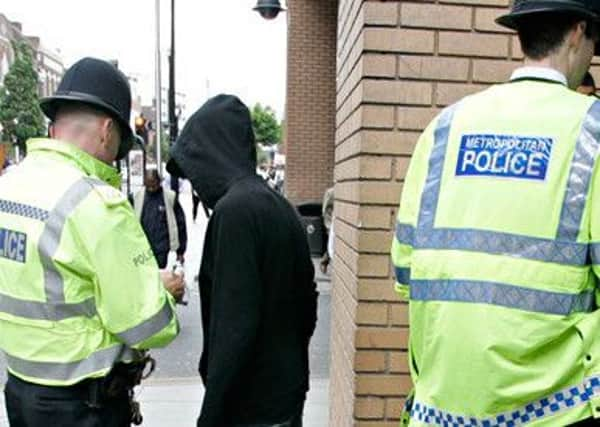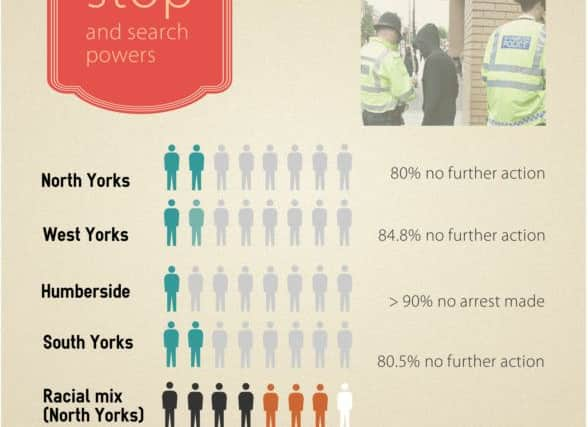Infographic: Police take no action on four in five ‘stop and searches’


A force-by-force breakdown of how the controversial powers have been used around the country in the last six months, published today by the Government for the first time, reveal an unprecedented level of detail about who is being stopped and where the stops take place.
In three out of Yorkshire’s four forces, at least 80 per cent of the stops carried out this year resulted in no further action being taken.
Advertisement
Hide AdAdvertisement
Hide AdThe exception was Humberside Police, where fewer than 10 per cent of stop and searches between December 2014 and February 2015 resulted in an arrest, a court summons, or another ‘police outcome’.


Sixty-eight per cent saw no further action taken but in a significant proportion, 21.67 per cent, the outcome of the stop and search was not collected by Humberside Police.
North Yorkshire Police took no further action after 80 per cent of stop and searches, South Yorkshire 80.5 per cent and West Yorkshire 84.8 per cent.
The figures also revealed that certain ethnic groups are considerably more likely to be stopped than others in some parts of the region.
Advertisement
Hide AdAdvertisement
Hide AdIn North Yorkshire, black or black British people were stopped an average of 10.23 times per 1,000 residents, and Asian or Asian British people 7.67 times, compared with a rate of 2.95 stops per 1,000 resident population for white people.
The proportion of black and Asian people stopped is based on 113 stops over six months, and it is not known how many of those stopped were North Yorkshire residents or had come into the county from elsewhere.
West Yorkshire Police has a smaller disparity between the number of white and non-white people stopped.
But, according to the figures, the region’s largest police force stopped and searched 1,555 White Irish people over the six months, meaning this group was more than ten times more likely to be searched than any other in the county.
Advertisement
Hide AdAdvertisement
Hide AdLeeds GATE, a charity working to improve the quality of life for Gypsies and Travellers, said it could not comment on whether the “wider white Irish population of West Yorkshire have problems with police stop and search”.
A spokeswoman said: “We are aware anecdotally , however, that many of our members who are Irish Travellers are stopped a lot by the police but we still find the recent statistics shockingly disproportionate.
“Maybe some of these number can be explained by the nature of work that many Irish Travellers take up such as self employed scrap metal or tree work that require permits. “GATE feel that many of our members, who are law abiding citizens of Leeds, spend an unfair proportion of their time answering producers and waiting for their details to be confirmed.
“We can only conclude that these statics partly reflect an element of victimisation in the way that Traveller communities are policed.”
Advertisement
Hide AdAdvertisement
Hide AdTemporary Assistant Chief Constable Angela Williams, of West Yorkshire Police, said: “Our stop search data does show that a higher proportion of people who self-identify their ethnicity as ‘White Irish’ have been stopped and searched over the last six months. “Any use of stop and search powers is intelligence-led either on the basis of information from the public or in response to criminality in a certain area and in exercising a stop and search power on an individual an officer must have reasonable grounds for suspicion.
“Anyone who has been stopped and searched can ask for a copy of this record. Every stop and search record is audited by a supervisor to ensure that the search was justified and done in accordance with the law.
“We also have long-established independent scrutiny panels who review the use of stop and search on a regular basis to ensure the powers have been used correctly and proportionately. No concerns have been raised as part of this scrutiny process in relation to the use of these powers on those of a white Irish background.”
She added: “Stop and search powers are an effective tool in helping to prevent and detect crime and the public quite rightly want to know that these powers are being used in an effective and proportionate manner.
Advertisement
Hide AdAdvertisement
Hide Ad“West Yorkshire Police was one of the first forces to sign up to the Home Office’s Best Use of Stop Search scheme as part of a commitment to achieve greater transparency, community involvement in the use of stop and search powers and to support a more intelligence-led approach, leading to better outcomes.
“For example, an increase in the stop and search to positive outcome ratio. We have already seen a reduction in the total number of stop and searches with just under 650 less people searched in June compared to January of this year.”
West Yorkshire Police and Crime Commissioner Mark Burns-Williamson said: “As West Yorkshire Police and Crime Commissioner it is my job to hold the police to account and having spoken with and listened to local communities I know that the use of stop and search powers is something that concerns people.
“I have listened to these concerns and agreed that the police would join the new Home Office scheme which sees details of police stops and searches mapped online. The initiative allows people to see exactly where this important power is used and the outcome and other details including ethnicity, gender and the age range of those who are stopped and searched.
Advertisement
Hide AdAdvertisement
Hide Ad“That doesn’t mean however that more can’t be done and I will continue to work closely with the Chief Officer Team to ensure the power is used appropriately and proportionally and will ask specifically why four out of five stops resulted in no police action and why people who class themselves as being ‘white Irish’ are more likely to be stopped than other people.”
Chief Inspector Mark Grange, of North Yorkshire Police’s Operations Command, said: “Stop and search powers are an effective tool in detecting crime, recovering property and arresting offenders.
“We recognise that such searches need to done based on the best available intelligence and conducted in an ethical and transparent manner.
“That is why North Yorkshire Police has adopted the Home Office’s Best Use of Stop and Search Scheme, which includes greater community involvement via the Stop and Search Lay Observer Scheme.
Advertisement
Hide AdAdvertisement
Hide Ad“We therefore welcome the increased transparency with the North Yorkshire Police stop and search data now readily available to the public on the police.uk website.”
A police officer has powers to stop and search members of the public if they have ‘reasonable grounds’ to suspect they are carrying illegal drugs, a weapon, stolen property or something which could be used to commit a crime.
But use of the powers has sparked anger in many parts of the country because of the perception that ethnic minority groups are being disproportionately targeted.
In April Home Secretary Theresa May said use of stop and search had become an “unacceptable affront to justice” after Her Majesty’s Inspectorate of Constabulary found that 27 per cent of searches did not contain reasonable grounds for suspicion.
Advertisement
Hide AdAdvertisement
Hide AdPolice forces are providing detailed data on their use of stop and search powers from today, meaning residents can see figures for the number of stops and their outcomes.
A total of 40 forces, including British Transport Police, will give information including the ethnicity and age of those stopped, on a monthly basis.
The data, released on summary pages on the police.uk website, will also cover the time of day stops are made.
Figures will be published alongside maps that allow the public to see where stop and searches took place, which are already provided by 25 forces.
Advertisement
Hide AdAdvertisement
Hide AdThe move is part of a drive by the Government to increase transparency over the controversial tactics.
Home Secretary Theresa May said: “Stop and search is undoubtedly an important police power.
“But when it is misused it can be counter-productive and an enormous waste of police time. If it is not operated in a targeted and proportionate way and if innocent people are stopped and searched for no good reason, it is hugely damaging to the relationship between the police and the public.”
She said the new pages “provide the public with a visual representation of how fairly and effectively stop and search is being used in individual police forces”.
Advertisement
Hide AdAdvertisement
Hide AdMrs May added: “This is a further step forward in the Government’s commitment to increasing the transparency of the police and ensuring the public can hold their force to account.”
Officials disclosed that data collection for the new project has resulted in a number of forces reviewing the quality of their statistics and rectifying inaccuracies in their reporting.
For example, some forces were inputting the date of the stop and search rather than the individual’s date of birth, which resulted in the appearance of a high number of searches of children under 10 years old when in fact the vast majority were actually adults.
Deputy Chief Constable Adrian Hanstock, National Police Chiefs’ Council lead on stop and search, said: “It is important that we do not lose sight of the fact that, on a daily basis, officers utilising the stop and search power are finding weapons, stolen property and drugs.
Advertisement
Hide AdAdvertisement
Hide Ad“The people committing a criminal act by carrying these items are the same people who can make communities less safe, and police must have appropriate powers at their disposal to find and deal with them.
“It is, however, very important that this power is used with great care and precision, acting on intelligence and reasonable suspicion that a suspect is in possession of something they should not be.”
He added: “Today’s data shows that the police service is moving in the right direction and is committed both to making improvements and maintaining community confidence that we are utilising stop and search in the best possible way.”
The most recent figures for England and Wales show the number of stops and searches has fallen by 31 per cent since 2009/10. Stop to arrest ratios have increased from nine per cent in 2009/10 to 12 per cent in 2013/14.